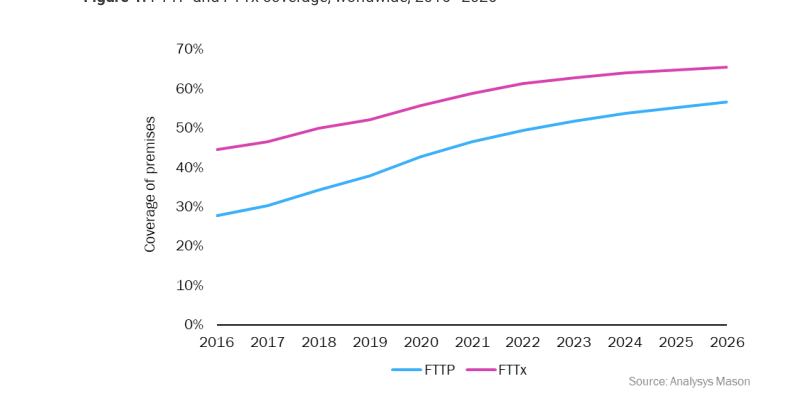We discuss the following topics in this blog:
- What is FTTP?
- What are optical distribution networks?
- Advantages & Challenges of FTTP
- STL’s FTTP Solution
In addition to these topics, we shall also be answering the following FAQs:
- Where is FTTP available?
- How Fast is FTTP?
- Is FTTP better than FTTN?
- Can I get FTTP to my house?
- How do you check if I have FTTP?
Contents
Overview
Businesses across the globe, high CapEx or low CapEx, have identified that efficient and high-speed data connectivity is as important a fuel as revenue for an organization’s well-being. FTTP internet is one such concept that can provide connectivity services that enterprises have never seen before.
What is FTTP?
The fibre to the premises is a network architecture that took its birth under the conception of FTTx network design. FTTP meaning can be decoded as one of the sub-groups amongst the other multiple sub-groups under the umbrella of FTTx. A typical fiber to the architecture of the premises runs on the optical distribution network (ODN.) FTTP is an optical fibre dependent communication delivery system where the optical fibre is directly run onto the customer’s premises.
It essentially aims at optimizing the FTTP broadband services for businesses. An optical signal over the ODN is distributed by the central office. And further, the optical signal is converted into an electric signal at the end of the network via the optical network terminals (ONTs.) Fiber to the premises has a significant advantage over other FTTx delivery mechanisms as it doesn’t make use of the traditional copper wires and delivers ultra-fast speeds.

What are Optical Distribution Networks?
ODN acts as a central pillar for setting up the FTTP broadband connections. The two optical ODNs are direct fiber and shared fibre.
The direct fibre, as the name suggests, a customer gets to avail the benefits of all the fibres coming from the central office solely. The high-speed bandwidth is surely a delight, but deployment costs do raise a concern as the entire central office machinery along with fibre quantity does get too costly in the end.
Shared fibre is an economical affair where multiple customers receive the common fiber from the central office. However, a split is made in the fibres when it gets too close to the customers. The individual user-specific fibres or the split is achieved via an AON (active optical network) or a PON (passive optical network.) The end goal is to separate and route data to the desired place.
Electric switching equipment is involved in an AON set-up, the direction of signals, and signal distribution management for specific customers, such as a switch aggregator or a fibre to the premises router. In order to direct the incoming and outgoing signals, the switch can be opened and closed in various ways.

The PON is quite similar to the AON architecture, but PON can make it without the OSP electronics. The OSP switch isn’t the requirement, and an optical splitter is used instead. The splitter makes a division of the light coming from the Optical Line Transmitter (OLT), and it also combines the light which makes its way from the Optical Network Terminal (ONT.)
Advantages & Challenges of FTTP
FTTP broadband performance can be supervised with extreme vigilance. Technical difficulties can be resolved even before the user gets to know about them. Super high bandwidth makes it a preferable choice for business owners as the speeds can go up to 1GB/s. The data upload and download can be achieved at the same speeds due to the symmetrical nature of the fibres.
The installation costs are high if compared with FTTC installations. And it also takes lengthy durations for the entire FTTP installation set-up as it might involve digging up the public roads. Not all businesses, especially small-cap and mid-cap, require such high-speed services, and even if they do, cost to benefit ratio is a legitimate concern.
STL’s FTTP Solution
It is clear that with 5G’s arrival, networks across the globe will demand massive fiberization. The hyper-connected 5G world is bound to open new chapters of how business enterprises will use data connectivity as fuel to leverage themselves. FTTP being the most desired solution for businesses, STL is committed to bringing forth robust fibre deployment by orchestrating our LEAD 360° solution.

STL LEAD 360° is designed to overcome the following fibre deployment challenges:
- The lean-agile approach will look for smart collaborations to counter the issue of multiple approvals.
- Everything Survey is a comprehensive surveying approach that will include LIDAR (light detection and ranging), 360° photogrammetry, and drones’ surveillance.
- The unskilled manpower challenges will be catered via our academy training initiatives.
- Manual planning and operations will be inspired by design-led planning, which aims at ensuring that planned work takes place on the ground as decided.
The vision is to achieve a 360° transformation with the current technological innovations such as machine learning, robotics, and tool-based project tracking.
FAQs
Where is FTTP available?
FTTP is now available in many countries but to ensure if, as an individual, you can have access to FTTP broadband, you should look it up online if FTTP has been rolled out in your area. You can easily obtain this piece of information via your zip codes. The best source would be the official communications regulator’s website of your countries such as Ofcom (UK) and others.
How Fast is FTTP?
FTTP is superfast if you compare the download and uploads speeds. The standard speed at the moment would be 100Mbps (download) and 40Mbps (upload.) Moreover, some FFTP fibre connections can even get to 1Gbps for download and 400Mbps for uploads.
Is FTTP better than FTTN?
The cost for both FTTP and FTTN is quite similar, but FTTP any day offers much better speeds. However, FTTN can be rolled out faster than FTTP. Eventually, it depends on your connectivity requirements, affordability, and infrastructure compatibility of various FTTx delivery options within your region.
Can I get FTTP to my house?
Yes, you can get an FTTP connection, but you will have to check whether FTTP broadband services are available in your area. Many service providers even have a free FTTP checker, which allows a user to investigate if FTTP connections are available in their localities.
How do you check if I have FTTP?
You can check the current status of the type of broadband services available in your area by using the online FTTP checker tools. Such sources act as intermediaries for service providers. They have a thorough database of all the service providers, and they inform you about the possible FTTP vendors based on your location.













